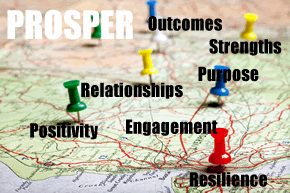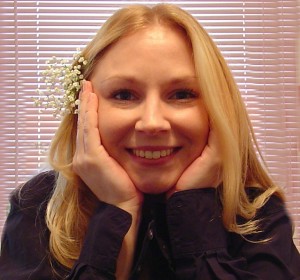 Keynote address: Positive Schools Conference 2015
Keynote address: Positive Schools Conference 2015
Everyone is interested in how to build and sustain happiness and a sense of wellbeing. This keynote overviews our new organiser: PROSPER for the wellbeing elements that help individuals, groups, organisations and communities thrive (Noble & McGrath, In Press a & b).
The term ‘to prosper’ means to thrive and succeed in a healthy way; to flourish.
The PROSPER acronym stands for Positivity, Relationships, Outcomes, Strengths, Purpose, Engagement, and Resilience.
Using prosper for Positive Schools provides a road map for the evidence-based school and classroom practices that build student wellbeing and student engagement in learning and build schools as safe and supportive learning communities. The term PROSPER has integrity as the word ‘to prosper’ reflects the intended purpose of the framework. It’s an easy-to-remember and easy-to-communicate message that has the potential to inspire your whole school community.
This application of PROSPER in education seems timely given Seligman’s recent challenge to policy makers to develop a new measure of prosperity, beginning early in life. Seligman (2011) states:
the time has come for a new prosperity, one that takes flourishing seriously as a the goal for education and of parenting. Learning to value and to attain flourishing must start early – in the formative years of schooling – and it is this new prosperity, kindled by positive education, that the world can now choose (Seligman, 2011 p.97).
The more PROSPER components that a student is able to access at school, the better their education and the higher their level of wellbeing and achievement is likely to be. Sustainable student wellbeing is seen as an outcome of the school policies, structures and practices that are organized under the PROSPER framework.
The PROSPER organiser builds on the authors’ two earlier versions of a positive psychology framework for education (Noble, McGrath et al 2008a) and (Noble & McGrath 2008b). PROSPER has some similarities with Geelong Grammar School’s (GGS) Positive Education framework recently outlined by Norrish (2015). The GGS’ domains are Positive emotions, Positive Relationships, Positive Accomplishment, Character Strengths, Positive Purpose, Positive Engagement and Positive Health and Resilience.
All the PROSPER wellbeing components and the school practices are derived from the positive psychological literature as well as the educational psychological literature.
Our definition of Positive education
Positive education is the integration of the core principles of Positive Psychology with the evidence-informed structures, practices and programs that enhance both wellbeing and academic achievement. The aim of positive education is to enable all members of a school community to succeed and prosper (Noble & McGrath 2015 a & b)
USING PROSPER IN THE SCHOOL CONTEXT
This keynote address began with a quote from Duncan Lewis, the Director of ASIO who said youth militant extremism is a social problem. He argued that treating extremism as a religious or national security problem is counter-productive (SMH, 15/5/15). He argued that if there is a solution, then we should focus on greater social cohesion. Schools are the most important social institutions and each element of PROSPER was explained with brief examples of how that element can be achieved in schools.
POSITIVITY for students means experiencing positive emotions at school such as feeling safe, a sense of belonging, interested, content and cheerful and experiencing a sense of fun and amusement, gratitude and appreciation, a capacity for mindfulness and skills in optimistic thinking.
Encouraging Positivity means providing opportunities for students to experience and amplify positive emotions and build positive learning environments. For example implementing curriculum that raises students’ curiosity and highly engaging, using music, dance, cooperative learning tasks, teaching mindfulness and optimistic thinking
RELATIONSHIPS for students refers to students experiencing ongoing positive relationships with peers and teachers; for parents it means experiencing ongoing positive relationship with teachers and the school; and for teachers it means experiencing ongoing positive relationships with their students and other school staff.
Building Relationships means teaching pro-social values (such as kindness, friendliness, cooperation) and social skills (such as listening, turn taking, negotiating and respectful disagreeing). It also means identifying and implementing school-based structures and practices that facilitate these positive relationships such as cooperative learning groups, cross-age teams, peer mentoring, cooperative games and performance groups.
OUTCOMES involves making progress toward goals, feeling capable to do schoolwork, understanding that accomplishment depends on hard work and effort, being persistent, and having a ‘growth mindset’, and a sense of mastery and achievement.
Facilitating Outcomes means teaching these attitudes and skills, using evidence-informed teaching strategies that facilitate both positive school-based outcomes (both academic and co-curricular); teaching critical and creative thinking and problem solving and acknowledging and celebrating the accomplishment of all members of the school community in a wide range of school-based outcomes.
STRENGTHS involves self knowledge about one’s character strengths and ability strengths and understanding how to apply these strengths in different contexts. Two useful frameworks for strengths in education are Peterson & Seligman’s (2004) character strengths and Gardner’s (2006) multiple intelligences for ability strengths.
Focusing on Strengths means assisting all members of the school community to identify their strengths, develop them further and find good ways to apply their strengths. For example differentiating learning tasks and sometimes allowing students choice based on their different students’ character and ability strengths (McGrath & Noble 2005a &b).
PURPOSE in the school context refers to believing that what one is learning at school is valuable and feeling connected to something greater than oneself. Of course it’s possible for a young terrorist to experience positive emotions, be resilient, be strongly connected to his terrorist gang or organisation, be highly engaged and achieve outcomes deemed as successful by this group and be very satisfied with his life. He may also have a deep seated sense of purpose. This illustrates the importance of Damon’s (2008) warning that we should carefully distinguish a noble purpose, which is morally acceptable and admirable, from an ignoble or evil life goal. A sense of Purpose is defined as ‘a stable and generalized intention to accomplish something that is at once meaningful to the self and of consequence to the world beyond the self’ (Damon et al., 2003)
Fostering a sense of Purpose means providing students with opportunities to participate in student-owned and student-directed activities, or looking for ways students can contribute their school community, to the general community and to people in need of care and support.
ENGAGEMENT refers to student’s psychological connection to learning activities and to school (e.g. feeling absorbed, connected, interested, and engaged in school learning and in school life).
Enhancing Engagement means implementing effective and evidence-informed teaching strategies that connect, challenge and scaffold student engagement and achievement (McGrath & Noble 2010). Also providing curriculum differentiation so students experience ‘flow’ when they are challenged in their area of strength.
RESILIENCE includes having the capacity to ‘bounce back’ after setbacks, mistakes and difficulties and being courageous when faced with challenging situations;
Teaching Resilience means explicitly teaching coping skills so students can act resiliently in both personal and academic contexts and implementing support structures (McGrath & Noble, 2011).
References
Damon, W., Menon, J., & Bronk, K. C. (2003). The development of purpose during adolescence. Applied Developmental Science, 7(3):119-128.
Gardner, H. (2006). Multiple intelligences: New horizons. New York: Basic Books
McGrath, H. & Noble, T. (2011). BOUNCE BACK! A Wellbeing & Resilience Program. Lower Primary K-2; Middle Primary: Yrs 3-4; Upper Primary/Junior Secondary: Yrs 5-8. Melbourne: Pearson Education.
McGrath, H. & Noble, T. (2010). HITS and HOTS. Teaching + Thinking + Social Skills. Melbourne: Pearson Education.
McGrath, H. and T. Noble, (2005a). Eight ways at once. Book One: Multiple Intelligences + Bloom’s Revised Taxonomy = 200 differentiated classroom strategies. Sydney: Pearson Education.
McGrath, H. and T. Noble, (2005a). Eight ways at once. Book Two: Units of Work Based Multiple Intelligences + Bloom’s Revised Taxonomy Sydney: Pearson Education.
Noble, T. & McGrath, H. (In press a). PROSPER: A new framework for Positive Education. Psychology of Well-being: Theory, Research & Practice.
Noble, T. & McGrath, H. (In press b). PROSPER for Student Wellbeing. Pathways and Policy. The Netherlands: Springer Brief
Noble, T. & McGrath, H. (2008a) The positive educational practices framework : a tool for facilitating the work of educational psychologists in promoting pupil wellbeing, Educational and child psychology, 25 (2), 119-134
Noble, T., McGrath, H. L. Roffey, S. & Rowling, L. (2008b). Scoping Study into Approaches
to Student Wellbeing: A Report to the Department of Education, Employment and Workplace Relations.
Norrish, J. (2015). Positive Education. The Geelong Grammar School Journey. Oxford University Press.
Peterson, C. & Seligman, M.E.P. (2004). Character strengths and virtues: A handbook and classification. Oxford: Oxford University Press.
Seligman, M.E. (2011), Flourish: A visionary new understanding of happiness and wellbeing, NY: Simon and Schuster.
Dr Toni Noble
Adjunct Professor
Institute of Positive Psychology and Education
Australian Catholic University
www.bounceback.com.au/ toni@bounceback.com.au


